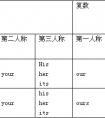单句改错。(每句有一处错误,请改正。) 1.There have eight oranges on the desk. 2.Alice and I are in a same school. 3.Is that bike his or your? 4.This photo look-七年级英语
例:She can play the piano. 她会弹钢琴。
He plays the violin very well. 他小提琴拉得很好。
He played the guitar for the children. 他给孩子们弹了吉他。
提示:
但乐器名词表示具体的器物,或表示课程时,不加the.
例:He bought a piano last month. 他上个月买了一架钢琴。
She taught piano in the school. 她在学校里教钢琴。
10 用在江河、海洋、湖泊、群岛、山脉的名称前例:
the Yangtze River 长江
the Red Sea 红海
the West Lake 西湖
the Pacific 太平洋the Himalayas 喜马拉雅山
the Nile 尼罗河
the Rocky Mountains 落基山脉
the South China Sea 南中国海
提示:
例外的情况: Mount Tai泰山 China Daily《中国日报》
11 用在由普通名词和另外一些词构成的国家名称、机关团体、阶级、等专有名词前
例:the Great Wall 长城
the United Nations 联合国
the New York Times 《纽约时报》
the United States of America 美国
the Red Cross Hospital 红十字医院the Olympic Games 奥林匹克运动会
the Shanghai Railway Station 上海火车站
the People's Republic of China 中华人民共和国
the North Pole 北极
the People's Daily 《人民日报》
12 用在某些形容词前,表示一类人或物或某种抽象概念
例:the old 老年人
the happy 幸福的人
the poor 穷人
the aged 老人
the sick 病人
the impossible 不可能的事the young 年轻人
the rich 富人
the blind 盲人
the wounded 伤员
the smooth 顺事
the beautiful 美,美的东西
例:The rich should help the poor. 富人应该帮助穷人。
The good is what people like. 人们总是喜欢美好的东西。
The wounded have been sent to the hospital. 伤员已经被送到医院去了。
13 用在姓氏的复数形式前,表示全家人或这一姓的夫妇二人
例:The Greens will more to the country. 格林一家要搬到乡下去。
The Wangs came to see us yesterday. 王家一家人昨天来看我们。
The Browns are very friendly. 布朗夫妇都很友好。
14 用在表示计算单位的名词前,含有“每,每一”的意思
例:Jim is paid by the hour. 吉姆的工资按小时付。
Eggs are sold by the kilogram. 鸡蛋按千克出售。
This cloth is sold by the yard. 这种布按码出售。
It sells at three dollars the pound. 它以每磅三美元出售。
They sell sugar by the pound. 他们按磅卖糖。
15 用在前面已提到过的人的身体部位或衣着的名词前
这种用法是先把整个对象说出来,然后再说到那个对象的身体的局部或衣着。
结构:动词(hit, pull, pat, strike, catch, hold, take)+sb.+介词(in, on, by, across)+身体部位或衣着
例:She touched him on the shoulder. 她碰了碰他的肩。
He took the girl by the hand. 他拉着小女孩的手。
He hit her on the nose. 他打了她的鼻子。
The stone struck the man in the eye. 石头击中了那人的眼睛。
I caught her by the right hand. 我抓住她的右手。
比较:她拍了拍那男孩的头。
She patted the boy on his head. (误,本结构中身体部位或衣着前不用one's)
She patted the boy on the head. (正)
16 用在逢十的复数数词前,表示年代,也指人的大约岁数
例:The war broke out in the forties. 那场战争发生在40年代。
He went abroad in the 1980s. 他在20世纪80年代出国的。
The old man is in the seventies. 老人大约七十几岁。
17 用在表示自然现象的名词前
这类名词有:
the rain 雨,the wind风, the fog雾,the snow雪, the air空气, the storm风暴,the snowstorm 暴风雪
例:Don't stand in the rain. 不要站在雨中。
The wind blew down the trees. 风把树刮倒了。
The ship sank in the storm. 船在风暴中沉没了。
The rain has cleaned the air. 下雨净洁了空气。
The fog was so thick that we couldn't see the top of the hill. 雾很大,我们看不见山顶。
提示
a 这类名词前有形容词修饰时,可用不定冠词,表示“一场,一阵,一种”
例:A cold wind is blowing from the north. 冷风从北方吹来。
There was a heavy rain last night. 昨晚下了一场大雨。
A heavy snow is falling outside. 外面正下着大雪。
b 这类名词表示一般物质时,不用冠词。
例:Rain falls in summer; snow falls in winter. 夏天下雨,冬天下雪。
Man can't live without air. 没有空气人不能活。
18 与复数名词连用,指整个群体
例: They are the teachers of this school.指全体教师)
They are teachers of this school.(指部分教师)
19 表示所有,相当于物主代词,用在表示身体部位的名词前
She caught me by the arm…… 她抓住了我的手臂。
20 用在某些习惯用语中
例:
in the morning 在上午
in the evening 在晚上
in the field 在田野里
in the country 在乡间
in the sun 在阳光下
in the distance 在远处
on the right 在右边
by the way 顺便说一下
in the front of 在前部
in the daytime 白天
go to the concert 去听音乐会
at (/in) the beginning 开始
at the moment 当时,此刻
all the year round 一年到头
go to the cinema 去看电影
go to the theatre 去看戏
at the weekend 周末in the afternoon 在下午
in the night 在夜里
in the sky 在空中
in the dark 在暗处
in the rain 在雨中
in the shade 在阴凉处
on the left 在左边
all the time 始终
in the middle of 在中间
on the way home 回家途中
all the same 依然
on the whole 总之
at the same time 同时
on the plane 在飞机上
in the year 2008 在2008年
the other day 前几天
at the bottom of 在……底部
in the end 终于
on the one hand, on the other hand 一方面,另一方面
提示:
下面几个短语前不加定冠词:
例:at dawn 在黎明
at night 在晚上
at noon 在正午
at dusk 在黄昏
the的固定用法:
一、在表示方位和方向的名词前面,一般要加the。如:
The sun rises in the east and sets in the west.
二、在乐器名称前面要加the。如:play the piano。
三、在形容词最高级或序数词之前一定要加the。如:the first,the best,等等。
四、表示全体总称(泛指)。
名词或者形容词前加the,可表示该事物的全体,如:the poor指“穷人”。
这一用法本身并不难,难在这一全体所表示的“数”上。
在一开始所举的例子中,the lion指的就是这“一”类,表示的是单数的概念。
但在下面这个例子中,the old又用单形表示了复数概念。
The old are apt to catch cold.
五、另外,定冠词the在固定词组中出现,需要多加注意,逐渐积累。
如:to tell the truth, to go to the theatre, to keep the peace, with the exception of, in the morning……
定冠词用法顺口溜:
特指双熟悉,上文已提及;
世上独无二,序数最高级;
某些专有名,习语及乐器。
注:定冠词常用于以下几种情况:
①“特指”某个或某些人或物前。例如:
The books on the desk are mine.书桌上的书是我的。
“双熟悉”指谈话双方都熟悉的人或事物前。例如:
Where is the teacher?老师在哪里?
②上文已经提到的人或事物前。例如:
I can see a cat.The cat is Lucy's.我能看见一只猫。那只猫是露茜的。
③世界上独一无二的事物前。例如:
The earth goes around the sun.地球围绕太阳转。
④序数词或形容词最高级前。例如:
September is the ninth month of the year.九月是一年中的第九个月。
Mike is the tallest of the three boys.迈克是三个男孩中最高的一个。
⑤由普通名词构成的专有名词前。例如:
the Great Wall(长城),
the People's Park(人民公园)等。
⑥一些习惯用语中或乐器前。例如:
in the day(在白天),
play the piano(弹钢琴)等。
不用冠词的几种情况:
下列情况应免冠,代词限定名词前;
专有名词不可数,学科球类三餐饭;
复数名词表泛指,两节星期月份前;
颜色语种和国名,称呼习语及头衔。
注:
①名词前已有作定语用的this,that,these,those,my,your,his,her,our,their,some等限定词。例如:
this eraser,her pencil-box,some boxes,these women等。
②泛指的不可数名词前一般不用冠词。例如:
meat,rice,water,bread,tea,milk,juice等。
③表示学科的名词前一般不用冠词。例如:
Chinese,maths,English,physics,history等。
④在三餐饭和球类运动前一般不用冠词。例如:
have breakfast/lunch/supper,play basketball/football/volleyball/table tennis/tennis/pingpong等。
⑤复数名词表示泛指时不用冠词。例如:
His parents are both workers.他父母都是工人。
The people in the room are doctors.房间里那些人是医生。
⑥季节、节日、星期、月份前不用冠词。例如:
- 最新内容
- 相关内容
- 网友推荐
- 图文推荐
| [家长教育] 孩子为什么会和父母感情疏离? (2019-07-14) |
| [教师分享] 给远方姐姐的一封信 (2018-11-07) |
| [教师分享] 伸缩门 (2018-11-07) |
| [教师分享] 回家乡 (2018-11-07) |
| [教师分享] 是风味也是人间 (2018-11-07) |
| [教师分享] 一句格言的启示 (2018-11-07) |
| [教师分享] 无规矩不成方圆 (2018-11-07) |
| [教师分享] 第十届全国教育名家论坛有感(二) (2018-11-07) |
| [教师分享] 贪玩的小狗 (2018-11-07) |
| [教师分享] 未命名文章 (2018-11-07) |

![—I want to know if ______ a concert in our school hall this weekend. —Yes. Nancy told me about it. [ ]A. there will have B. there will be C. will there be -九年级英语](http://www.00-edu.com/d/file/ks/4/2/there be juxing/2020-02-28/small8bcf29e494d6f99c2d7c4286c4836a101582899344.jpg)
![There_____ a potato and two tomatoes on the table. [ ]A. isB. areC. hasD. have-七年级英语](http://www.00-edu.com/d/file/ks/4/2/there be juxing/2020-02-28/small596b7df57071a5318d44b4246a8dfcf71582899941.jpg)

![Will there___any schools in the future?[ ]A. isB. areC. amD. be-七年级英语](http://www.00-edu.com/d/file/ks/4/2/there be juxing/2020-02-28/smallfaad594ad286847556f8b2a7bf4e6da41582899915.jpg)
![There is going to _____English movie tonight. [ ]A. be B. be an C. have D. have an -八年级英语](http://www.00-edu.com/d/file/ks/4/2/there be juxing/2020-02-28/small684c03bf16377c6f94e9f828954421a91582899285.jpg)
